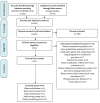Strategies to Reduce the Rate of Plate Waste in Hospitalized Patients: A Scoping Review
- PMID: 36678172
- PMCID: PMC9863156
- DOI: 10.3390/nu15020301
Strategies to Reduce the Rate of Plate Waste in Hospitalized Patients: A Scoping Review
Abstract
There is evidence that hospital waste is indisputably high, and various strategies have been used to reduce the hospital's rate of plate waste. This study aimed to map the currently implemented strategies in lowering the rate of plate waste in hospitals and categorize the different types of strategies used as interventions, as well as determine their impact based on specific parameters. The scoping review method included a search of three databases using the Preferred Reporting Items for Systematic Reviews and Meta-Analyses (PRISMA-SCR). The duplicate articles (n = 80) were removed. A total of 441 articles remained for the title and abstract screening. After 400 were excluded, 41 articles were reviewed for eligibility. Thirty-two full articles were eliminated due to a lack of focus on plate waste evaluation. Finally, nine accepted studies were grouped into five categories: menu modification, room service implementation, menu presentation, meal-serving system, and dietary monitoring tool. In conclusion, results showed that the majority of the studies implemented either of the five strategies to reduce plate waste; however, the cook-freeze system and staff training for both kitchen and ward staff were not yet part of any intervention strategy. The potential of this method should be explored in future interventions.
Keywords: foodservice; hospital food waste; hospital plate waste; malnutrition.
Conflict of interest statement
The authors declare no conflict of interest.
Figures


Similar articles
-
Challenges and strategies to reduce food waste in malaysian hospitals from the perspective of multidisciplinary professionals: a qualitative descriptive study.BMC Health Serv Res. 2025 Feb 10;25(1):224. doi: 10.1186/s12913-025-12365-w. BMC Health Serv Res. 2025. PMID: 39930430 Free PMC article.
-
Beyond the black stump: rapid reviews of health research issues affecting regional, rural and remote Australia.Med J Aust. 2020 Dec;213 Suppl 11:S3-S32.e1. doi: 10.5694/mja2.50881. Med J Aust. 2020. PMID: 33314144
-
Room Service Improves Nutritional Intake and Increases Patient Satisfaction While Decreasing Food Waste and Cost.J Acad Nutr Diet. 2018 Feb;118(2):284-293. doi: 10.1016/j.jand.2017.05.014. Epub 2017 Jul 1. J Acad Nutr Diet. 2018. PMID: 28676228
-
Impact of electronic bedside meal ordering systems on dietary intake, patient satisfaction, plate waste and costs: A systematic literature review.Nutr Diet. 2020 Feb;77(1):103-111. doi: 10.1111/1747-0080.12600. Epub 2020 Jan 19. Nutr Diet. 2020. PMID: 31957199 Free PMC article.
-
Implementation of sustainable food service systems in hospitals to achieve current sustainability goals: A scoping review.Clin Nutr ESPEN. 2024 Jun;61:237-252. doi: 10.1016/j.clnesp.2024.03.030. Epub 2024 Apr 3. Clin Nutr ESPEN. 2024. PMID: 38777440
Cited by
-
Challenges and strategies to reduce food waste in malaysian hospitals from the perspective of multidisciplinary professionals: a qualitative descriptive study.BMC Health Serv Res. 2025 Feb 10;25(1):224. doi: 10.1186/s12913-025-12365-w. BMC Health Serv Res. 2025. PMID: 39930430 Free PMC article.
-
'A Necessary Idea Given Our Current Climate': A Qualitative Study of Stakeholder Perspectives and Actions Required to Increase the Proportion of Plant to Animal Protein in Hospital Patient Menus.J Hum Nutr Diet. 2025 Jun;38(3):e70059. doi: 10.1111/jhn.70059. J Hum Nutr Diet. 2025. PMID: 40292609 Free PMC article.
References
-
- De Visser-Amundson A. A Multi-Stakeholder Partnership to Fight Food Waste in the Hospitality Industry: A Contribution to the United Nations Sustainable Development Goals 12 and 17. J. Sustain. Tour. 2020;30:2448–2475. doi: 10.1080/09669582.2020.1849232. - DOI
-
- European Environmental Agency What Are the Sources of Food Waste in Europe? [(accessed on 26 October 2022)];2016 Available online: https://www.eea.europa.eu/media/infographics/wasting-food−1/image/image_....
-
- Benson I. WRAP Running Month of Restaurant Food Waste Action. 2019. [(accessed on 26 October 2022)]. Available online: https://resource.co/article/wrap-runningmonth-restaurant-food-waste-action.
-
- Garcia-Garcia G., Woolley E., Rahimifard S. A framework for a more efficient approach to food waste management. Int. J. Food Eng. 2015;1:65–72. doi: 10.18178/ijfe.1.1.65-72. - DOI
Publication types
MeSH terms
Grants and funding
LinkOut - more resources
Full Text Sources

